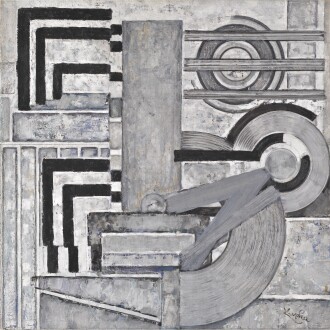Works by František Kupka at Sotheby's
František Kupka Biography
Czech painter and graphic artist František Kupka was one of the founders of Abstractionism (alongside Kandinsky and Malevich), and Orphism. Kupka resisted being directly associated with any singular movement and instead explored several artistic movements which arose throughout the course of the 20th century. In particular, he worked closely with the Cubists and was greatly influenced by Futurist and Fauvist artists. A self-proclaimed “colour symphonist”, Kupka made it his agenda to express his inner states through the harmonies and rhythms produced solely through colour and line instead of figurative and realistic elements.
Born in 1871 to a humble family in East Bohemia, Kupka first studied as an apprentice to the saddler Josef Šiška, a spiritualist who introduced Kupka to ideas about the cosmos and spirituality, concepts that Kupka drew upon in his early paintings and drawings that explored religion, geometry and colour. He then enrolled at Jaroměř under Alois Studnička in preparation for his move to Prague in 1889 to study at the Academy of Fine Arts under the conventional late romantic, František Sequens, during which time historical and patriotic themes formed the basis of his work. After relocating to Vienna’s Academy of Fine Arts, his art took a new direction, focussing on symbolic and allegorical subject matter that was more in keeping with contemporary tastes; whilst in Vienna, Kupka exhibited at the Kunstverein. He subsequently moved to Paris to continue his artistic training at the Académie Julien and the École des Beaux-Arts. Kupka settled in Paris in the spring of 1885; during his Paris years, Kupka produced a large number of works after nature and satirical fantasies and also co-founded the international group Abstraction-Création.
Kupka’s fascination with the science of movement first manifested itself in his art between 1901 and 1902 with the work The Horsemen in which he experiments with vertical planes. He returned to these experiments in 1909, introducing geometric motifs and juxtaposing his subjects. Between 1904 and 1911, however, Kupka consecrated a large part of his creative energy to book illustrations. In 1899 he began selling drawings to various journalism publications such as Cocorico, L’Assiette au beurre and L’Illustration, as well as designing posters for cabarets such as Le Chat Noir and L’Ane Rouge. By the end of this period, Kupka’s work veered more and more towards abstraction as he explored theories of colour and the link between painting and music.
Kupka exhibited for the first time in 1906 at the Salon d’Automne with his landmark painting Amorpha: Fugue in Two Colours. From this point on, he began to exhibit more regularly, such as at the Salon des Indépendants, Galerie Povolozky, and at the Museum of Modern Art in New York in 1936. After his death in 1957, retrospective exhibitions were held at the Musée National d’Art Moderne in Paris (1958) and the Solomon R. Guggenheim Museum in New York (1975). Today, amongst many other prestigious institutions, Kupka’s work can be found in the Musée d’Orsay, the Cleveland Museum, the Met and the Guggenheim Museum in New York, and the Peggy Guggenheim Collection in Venice.













